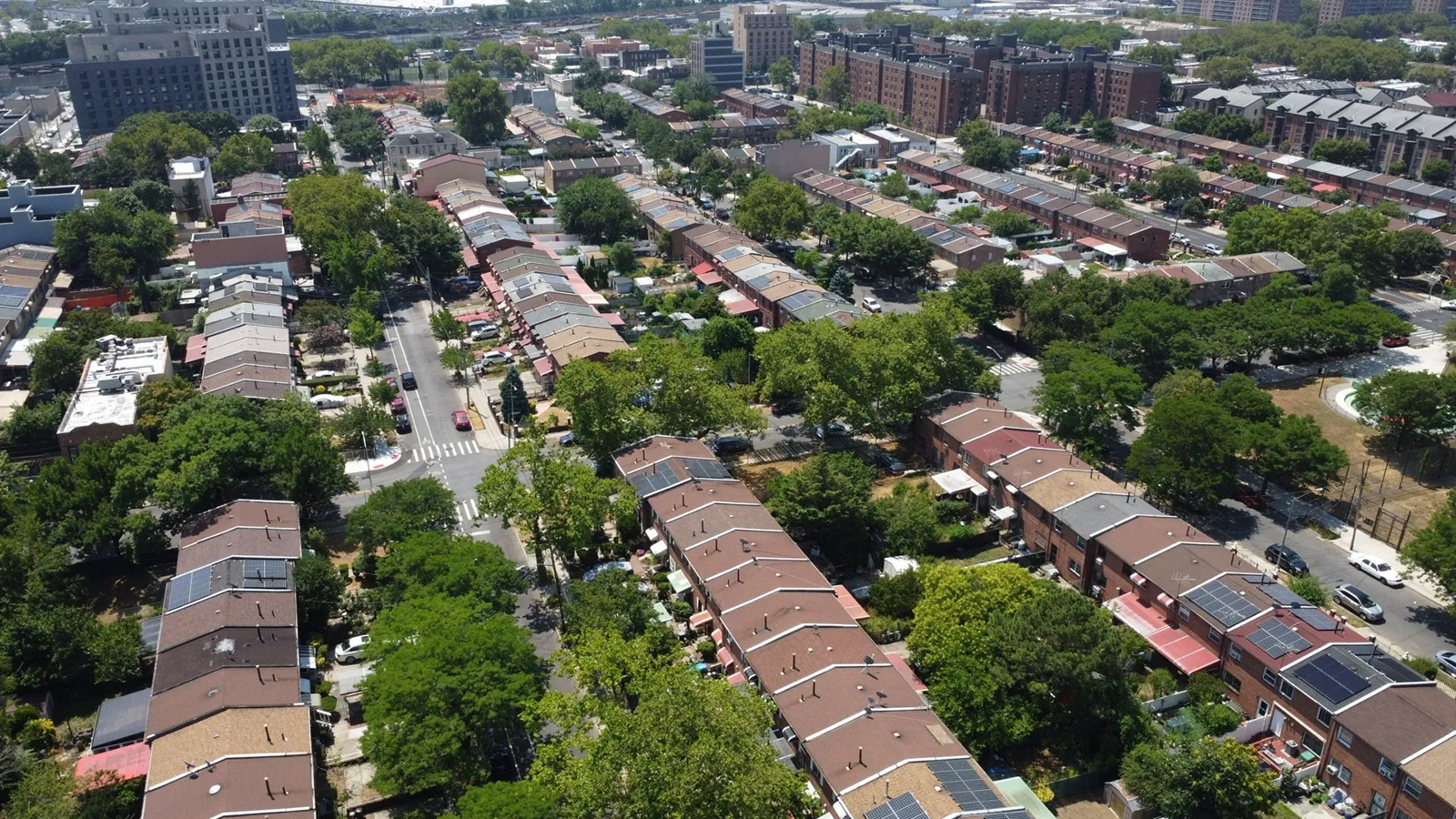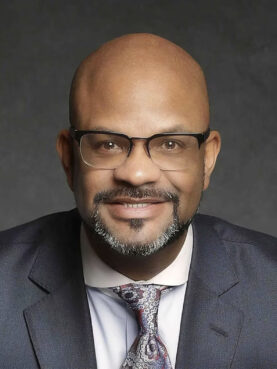
NEW YORK (RNS) — Not a week goes by at St. Paul Community Baptist Church in Brooklyn without the congregation having to bid farewell to another member. Since the end of the pandemic, many young families and retirees have left the East Brooklyn church because they can’t afford to live in New York City anymore.
Until recently, the 3,000-member congregation hosted three Sunday morning services: 6 a.m., 8 a.m. and 11 a.m. However, it has canceled its 6 a.m. service, formerly frequented mostly by older congregants, sometimes 300 at once. The church has since invested in its online programming to keep up with the hundreds of members who have relocated to places like Atlanta, Charlotte and Philadelphia.
These regular goodbye sessions have also taken an emotional toll on the congregation, noted the Rev. David K. Brawley, St. Paul’s lead pastor.
“Some of my core leaders walk up to me in tears saying, ‘I just can’t,’ and almost, seemingly in shame, ‘I can’t afford to stay here anymore,’” he said.
St. Paul Community Baptist Church, and other churches located in the East New York neighborhood of Brooklyn, are joining together in hopes of reversing the tide by keeping the neighborhood accessible to low-income families. Among other ideas, the churches want to encourage other houses of worship to build affordable housing on their vacant lots.

The Rev. David K. Brawley. (Photo courtesy St. Paul Community BC)
One of the main challenges today is finding land on which to build housing. Church-owned parcels can be repurposed for this, Brawley said, noting that churches could also bank on these housing projects to diversify their revenue since many are struggling financially as congregations shrink.
St. Paul Community Baptist believes up to 800 affordable units could be built on its parking lots. The church’s application to use city land is currently in its last stage, the Uniform Land Use Review Procedure, which can take about seven months.
After being reviewed by the Department of City Planning, the application will be examined by community boards impacted by the project, the borough president, the city planning commission, the city council and the mayor.
The church has also suggested that underutilized parking lots in existing public housing complexes could be used to build up to 15,000 senior housing units. It also believes schools, hospitals and state-owned parcels offer great opportunities for housing construction.
New York has launched similar efforts in other neighborhoods. The city administration, in 2016, launched the New York Land Opportunity Program to support faith-based organizations in their construction projects. The initiative was brought by the Department of Housing Preservation and Development and the Mayor’s Community Affairs Unit in partnership with Local Initiatives Support Corporation New York (LISC NY), a nonprofit advocating for community development.
Five churches were selected as part of the program and received technical assistance from attorneys, architects and LISC housing officers to draft requests for proposals. The congregations involved were the Community Church of New York in Manhattan; St. Luke’s Episcopal Church in the Bronx; Shiloh Church of Christ in Central Harlem; Wakefield Grace Methodist Church in Wakefield, Bronx; and St. John’s Global Ministries in Queens.
Shiloh Church of Christ told RNS the program was helpful and gave the church much-needed direction to set up a request for its proposal and to advertise the project. The church now waits to land a deal.

Congregants attend a service at St. Paul Community Baptist Church in Brooklyn, N.Y., Sunday, Nov. 3, 2024. (Photo by Shiyah Trotman/St. Paul Community BC)
When it comes to anything housing related, churches can find it challenging to navigate the city’s complex housing preservation and development procedures to open private-owned land to housing development.
“Sometimes, because of the lack of technical expertise of churches, they don’t get into the pipeline, or they’re at the back end of the pipeline,” said Brawley. “The city ought to really work to alleviate some of the red tape so that congregations can build.”
The Uniform Land Use Review Procedure process is inherently long, pointed out Council Member Crystal Hudson, who represents the Brooklyn neighborhoods of Crown Heights, Prospect Heights, Clinton Hill and Fort Greene. But for faith-based organizations and houses of worship that often lack appropriate counseling, it can be even more complicated.
“A lot of them are land-rich and cash-poor. They have assets, they have the property, but they don’t necessarily have the cash to always pay all of the consultants and withstand the two-year-plus process. I think that’s probably one of the biggest challenges with the ULURP,” said Hudson, who sits on the City Council Committee on Housing and Buildings.
In December, the City Council approved The City of Yes for Housing Opportunity text amendment that aims to simplify “overly restrictive zoning rules,” recognizing previous rules discouraged some organizations from building housing on their properties.
The new text would allow faith-based organizations to convert convents, school buildings and other properties into housing, according to the DCP website. It would also facilitate the development of three- to five-story buildings in low-density areas close to transportation or on a commercial street.
As part of the City of Yes for Housing Opportunity, the City Council also approved a $5 billion investment toward affordable housing, homeownership, tenant protection and neighborhood infrastructure. The City for All Housing plan, approved in November, includes a $1 million investment to finance technical assistance for faith-based and community-based organizations in their plans to build housing on their land.
Casey Berkowitz, a DCP spokesperson, said feedback from community members, including faith-based organizations, on their difficulties navigating the overly complicated procedure helped reshape the process.
“Part of that was based on input from faith-based organizations who sought to build affordable housing and were running into various challenges, frequently in zoning,” said Berkowitz. “They’re extremely valued partners of ours, who obviously have a trusted role to play in the community.”
St. Paul’s recent efforts to support affordable housing projects in the city align with the church’s long history of housing advocacy in the neighborhood. The congregation was created in 1927 by 15 Black Americans who settled in East New York after fleeing the Jim Crow South during the Great Migration. They felt a calling to strengthen the community and wanted it reflected in the congregation’s name. Besides its spiritual mission, St. Paul Community Baptist Church believes it has a mandate to impact the East New York community, said Brawley. The church is known in the neighborhood for its advocacy work against firearms, its success in creating a charter school and its campaigns to clean local supermarkets.
“We understand that to be in our DNA. It’s a part of our identity. We see our role as doing the work of social justice, not as an addendum to our mission, but it’s actually at the core of our identity,” said the reverend, pointing to a 40-year-old project he sees as a model for St. Paul Community Baptist’s new affordable housing efforts.
In the early 1980s, East Brooklyn Congregations, an alliance of neighborhood churches — including St. Paul Community Baptist — and aided by Metro-IAF, a faith- and community-based organization network, convinced Mayor Koch’s administration to sell empty parcels used as landfills and build 5,000 units of affordable housing.
At the time, the neighborhood had been labeled the “murder capital of the state,” and few wanted to bet on the project. Even residents weren’t enchanted by the prospect of buying property there. After years of advocacy, the city administration agreed to sell 16 square miles of the abandoned parcels to the churches for a dollar per lot.
The complex was baptized Nehemiah Homes, in reference to the Old Testament character who spearheaded the reconstruction of Jerusalem in the fifth century BCE.
Some houses went for $40,000, allowing families to buy who had previously been excluded from homeownership opportunities by banks’ redlining practices.
Brawley, now the co-chair of Metro-IAF, the nonprofit that developed the Nehemiah homes, believes the same tools that helped build those first homes can be useful in solving the current housing crisis: “urgency, imagination, and will.”
“The one thing that I know God’s not making more of, and that’s land. And so when you have opportunities, you got to maximize those opportunities if you want to make sure that you can provide the supply for New Yorkers,” he said.
